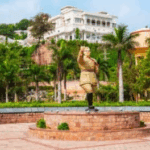
Exploring Dambulla Caves: A Journey Through Sri Lanka’s Sacred History

Nestled in the heart of Sri Lanka, the Dambulla Cave Temple, also known as the Golden Temple of Dambulla, stands as one of the country’s most revered and historically rich sites. This UNESCO World Heritage site is a stunning example of ancient Buddhist art and architecture, offering visitors a glimpse into Sri Lanka’s spiritual and cultural heritage. From its fascinating history to the breathtaking views from the top, the Dambulla Caves provide a truly captivating experience.
Historical Background
The Dambulla Cave Temple complex dates back to the 1st century BC, making it one of the oldest and best-preserved cave temple complexes in Sri Lanka. According to historical records, King Valagamba (also known as Vattagamini Abhaya) took refuge in these caves during his 14-year exile from Anuradhapura, the ancient capital. After reclaiming his throne, he transformed the caves into a magnificent temple as a gesture of gratitude.
Over the centuries, various kings have contributed to the development and embellishment of the Dambulla Caves, resulting in a rich tapestry of art and architecture that spans over 2,000 years. The complex consists of five main caves, each adorned with intricate statues, murals, and paintings depicting the life of Buddha and important events in Buddhist history.
Architectural and Artistic Marvel
The Dambulla Cave Temple is renowned for its stunning Buddhist mural paintings and an impressive collection of Buddha statues. Here’s a closer look at the highlights:
- Cave 1 (Devaraja Viharaya): Also known as the “Temple of the King of the Gods,” this cave features a 14-meter long reclining Buddha statue and several seated and standing Buddha figures.
- Cave 2 (Maharaja Viharaya): The largest and most impressive cave, known as the “Temple of the Great Kings.” It houses 56 Buddha statues, including a 14-meter-long reclining Buddha, and vibrant murals covering the ceiling and walls.
- Cave 3 (Maha Alut Viharaya): Known as the “Great New Monastery,” this cave features a large seated Buddha statue surrounded by 50 smaller Buddha statues and intricate murals.
- Cave 4 (Pachima Viharaya): Contains a large seated Buddha statue and several smaller statues, along with vivid frescoes.
- Cave 5 (Devana Alut Viharaya): The smallest cave, featuring a reclining Buddha statue and several deities.
Speculations and Mysteries
The origins and purposes of some of the features within the Dambulla Caves remain a topic of speculation among historians and archaeologists. Some believe that certain statues and murals predate the arrival of Buddhism in Sri Lanka, indicating that the caves may have been used for other religious purposes before being converted into a Buddhist temple.
Personal Experience
Visiting the Dambulla Caves is a journey through time and spirituality. The climb to the caves is relatively steep, but the effort is well worth it. As you ascend, you’ll be greeted by panoramic views of the surrounding countryside, with lush greenery stretching as far as the eye can see.
The View from the Top
Reaching the top of the Dambulla Caves offers a breathtaking view of the central plains of Sri Lanka. The vantage point provides a sweeping panorama of the lush landscape, dotted with distant mountains and forests. On clear days, you can even spot the iconic Sigiriya Rock in the distance, another of Sri Lanka’s treasured historical sites.
Proximity and Accessibility
Dambulla is conveniently located in central Sri Lanka, making it easily accessible from major cities. It is approximately 148 kilometers from Colombo and about 72 kilometers from Kandy. The site is also close to other significant cultural landmarks, such as Sigiriya and Anuradhapura.
Statistics and Quick Facts
- Location: Central Sri Lanka, near the town of Dambulla
- Elevation: Approximately 160 meters above the surrounding plains
- UNESCO World Heritage Site: Designated in 1991
- Distance from Colombo: Approximately 148 kilometers
- Distance from Kandy: Approximately 72 kilometers
- Number of Caves: Five main caves
- Visitor Numbers: Over 1 million annually
Conclusion
The Dambulla Cave Temple is a remarkable blend of history, art, and spirituality. Its well-preserved murals and statues offer a vivid glimpse into ancient Buddhist culture, while the panoramic views from the top provide a serene and awe-inspiring experience. Whether you are a history enthusiast, a spiritual seeker, or simply a traveler looking to explore Sri Lanka’s cultural heritage, the Dambulla Caves are a must-visit destination. My visits to this sacred site have deepened my appreciation for the island’s rich history, and I highly recommend experiencing it for yourself.
Hello, I am Aman (: Full Time Traveler :) At the age of 41, in April 2023, fueled by my love for travel and the determination not to remain fixed like a tree, I embarked on a bold journey. Having dedicated 17 years to a corporate job, I chose to transition from a full-time employee to a full-time traveler, driven by the desire to break free from the routine and constraints of a conventional life. Along the way, I not only explored the wonders of travel but also uncovered the transformative power of financial freedom. I realized how it could liberate me to lead a life teeming with adventure, purpose, and fulfillment. Through my blogs, I am passionately sharing my story, aiming to inspire and provide valuable guidance to those, like me, who aspire to weave travel into a life overflowing with limitless possibilities.






















Post Comment
You must be logged in to post a comment.